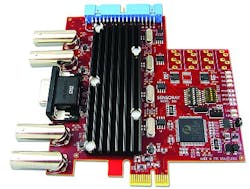4-Channel PCI Express video and audio frame grabber for surveillance introduced by Sensoray
The low-latency and real-time video solution simultaneously captures four channels of analog NTSC/PAL video and four channels of stereo audio. It captures raw video frames from each channel to full frame rate, resulting in an aggregate frame capture rate as fast as 120 frames per second for NTSC and 100 frames per second for PAL.
The high frame capture rate through a one-lane x1 PCI Express interface complements four BNC connectors available on the board's mounting bracket for connecting external composite video sources. A DB15 connector on the same bracket is used for the audio inputs. A 34-pin header provides an alternative access to all I/O signals on the board.
The unit supports video capture resolutions, including D1, VGA, QVGA, QQVGA, SIF, 2SIF, 4SIF, CIF, QCIF, SQCIF and 4CIF. Captured frames are formatted as raw RGB or YUV. Third party or OSS CODEC can be used for compressed video/audio capture. The audio can be stereo or mono, and the sampling rate supports 32 kHz, 44.1 kHz, and 48 kHz.
Embedded data may be added to each frame during the vertical blanking interval (VBI). Since the display is inactive during this interval, it can be used to transmit time codes, closed captioning, teletext, CGMS-A copy-protection indicators, and various data encoded by the XDS protocol.
Sensoray provides an SDK for the model 810 that includes drivers, programming examples and comprehensive documentation for both Windows and Linux operating systems.
For more information contact Sensoray online at www.sensoray.com.
